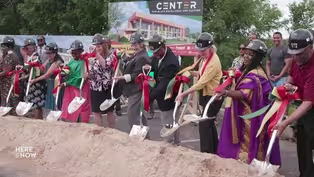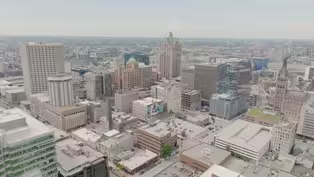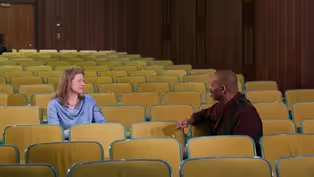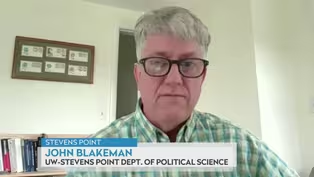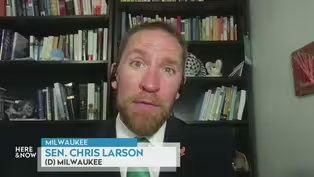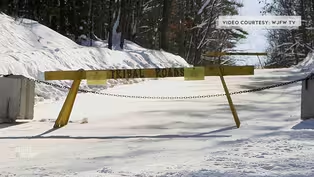Here and Now
Rich Barnhouse on Continuing Closures of 2-year UW Campuses
Clip: Season 2200 Episode 2249 | 7m 49sVideo has Closed Captions
Richard Barnhouse on the impact more closures to 2-year UW campuses will have on students.
Waukesha County Technical College President Richard Barnhouse explains the impact closures to 2-year Universities of Wisconsin programs has, and how technical colleges are trying to provide solutions.
Problems playing video? | Closed Captioning Feedback
Problems playing video? | Closed Captioning Feedback
Here and Now is a local public television program presented by PBS Wisconsin
Here and Now
Rich Barnhouse on Continuing Closures of 2-year UW Campuses
Clip: Season 2200 Episode 2249 | 7m 49sVideo has Closed Captions
Waukesha County Technical College President Richard Barnhouse explains the impact closures to 2-year Universities of Wisconsin programs has, and how technical colleges are trying to provide solutions.
Problems playing video? | Closed Captioning Feedback
How to Watch Here and Now
Here and Now is available to stream on pbs.org and the free PBS App, available on iPhone, Apple TV, Android TV, Android smartphones, Amazon Fire TV, Amazon Fire Tablet, Roku, Samsung Smart TV, and Vizio.
Providing Support for PBS.org
Learn Moreabout PBS online sponsorshipannouncement that UW Oshkosh Fox Cities will close at the end of this school year brings to six the number of two year campus closures across the state, what some have called a demographics.
Cliff leaves, enrollments at the branch campuses, falling to the point where the UW administration says the status quo is not sustainable because even with deep cuts and closures, the universities of Wisconsin System projects a nearly $17.5 million deficit through 2025.
Now, it's not like the writing hasn't been on the wall, or that people haven't tried to stave off closures.
But our next guest says, what's happening now?
Didn't have to be inevitable.
Rich Barnhouse is President of the Waukesha County Technical College and a former vice chancellor in charge of enrollment at UW colleges.
We should note PBS Wisconsin is part of UW-Madison.
>> I think if there had been a collective approach to looking at what was going to be coming down the line and about 10 or 15 years with really, acute thinking about what we wanted to be as a system, as, as universities, as we approach 2030 and 2035, taking into consideration things that we knew were real demographics.
Right?
We we've known for years, not just in Wisconsin, but across the country, that there was going to be a major change in the demographics that were going to impact colleges and universities.
That's certainly things that we couldn't really anticipate.
You know, one of those obviously being how people feel about a college or university education and what Gen Z was going to do or be interested in when they got to college, or what type of experience they wanted, how much they were willing to pay those things we couldn't really see.
But the thing that we could was simple demographics.
And had we started thinking about it in a proactive way early on, I think we could have had a robust conversation and come up with some reasonable solutions.
I don't think that that would have meant that nothing would have changed, or that there wouldn't have been things that might have contracted, but it might have been done in a way that I think people would have found a little bit more reasonable.
>> It is true that people have been talking about that so-called demographic cliff for decades.
Why the inaction?
>> You know, I'll just speak broadly about higher education in general.
I've worked on a number of different states.
I think that there is this concept that if we continue to do what we're doing, which is really, really good, truthfully, if we continue to do it, the forces, the market forces, the demographic forces won't impact us because what we're doing is really, really good work.
And it's having a major impact on society and the economy.
So I think higher education has often been shielded from what businesses find to be a harsh reality.
And now in higher education across the country and of course, Wisconsin as well, we find ourselves in the middle, right directly in the middle of that reality.
>> As to the two year colleges, which are the ones that are being announced, are closing or have closed already, was there ever a benefit to the duplication of the four year and the two year campuses?
>> Sure.
There was absolutely.
For years and years, the two year UW really behaved like the elastic band for the system.
So as enrollment changed over time, sometimes there would be ballooning enrollments and then sometimes there would be a decline.
And so the UW colleges for years served as that elastic band that really managed, I think, quite well, how many students were going into the four year institutions and managing that on the front end?
And so I think there was a time where it did work really well.
The other thing is, you know, years ago there just wasn't the technology available to do anything remotely or by distance.
And that certainly over the past 20 or 25 years has changed things as well.
And I think also, and this is just my opinion, but there was a significant tie to local communities that students coming out of high schools had.
And that's changed quite dramatically as well.
>> Why not just kind of have the technical college system take over the UW two years?
>> My immediate thinking on that is what merger does is it simply moves an existing issue or problem somewhere else.
It doesn't solve that problem.
So, for example, if the two two year systems, colleges and the tech colleges were combined, the problem still exists.
The number of campuses, the declining enrollments, the number of faculty, and the overall financial picture that doesn't change at all.
It just shifts where that issue goes and who has to solve it.
And so for that reason, merger isn't a solution.
It just moves the problem to a different place.
>> And yet I thought I read that you said that, for example, at your technical college, you have capacity, you have space, you have the infrastructure.
So what does that mean?
>> Well, I can give you a real life example of what we're doing right now.
So Chancellor Mahoney.
Chancellor.
Chancellor Milwaukee, a good friend and colleague of mine.
We've been talking for a number of years, and recently you've probably heard that UW Milwaukee is closing their Waukesha campus.
So what Chancellor Mahoney and I decided to do was not simply bring those the majority of those students over, should they want to continue to Wkctc.
We decided to take a significant leap forward.
And I think what could be a model for the state, and that is we're going to build a, university center right on our campus so that students can participate with Wkctc as well as, and what we really know is going to happen is that a lot of students will start in their associate degree of a variety of fields and end up taking baccalaureate degree classes, is that anybody in the community can take anything from a short term certificate all the way through graduate programs right on our campus with seamless interaction.
So that students really don't feel the sort of jerky thing that happens during a traditional, transfer process.
>> And how is that being looked at?
On the part of administration, UW like it is a model?
>> Well, I, I think and to their credit, the other campuses are thinking we're going to wait and see if Chancellor Mooney and President Barnhouse and their teams can pull this off.
We know that we will.
We're very excited about it.
And I think that the response from both systems has been, I would say, very positive and really supportive.
And I think for the legislators that I've spoken with, they're also quite supportive of us taking a different look at how we can provide higher education in a really strong partnership way, almost like siblings, and almost like siblings, and
Center for Black Excellence Marks Groundbreaking in Madison
Video has Closed Captions
Clip: S2200 Ep2249 | 1m 8s | Hundreds attend groundbreaking for The Center for Black Excellence and Culture in Madison. (1m 8s)
Here & Now opening for June 21, 2024
Video has Closed Captions
Clip: S2200 Ep2249 | 1m 10s | The introduction to the June 21, 2024 episode of Here & Now. (1m 10s)
In Focus with Courtney Bell: Teachers, Students in Wisconsin
Video has Closed Captions
Clip: S2200 Ep2249 | 34m 46s | Murv Seymour talks with Courtney Bell about classroom innovations, challenges, inequities. (34m 46s)
John Blakeman on Impacts of Trump's Rhetoric Among Voters
Video has Closed Captions
Clip: S2200 Ep2249 | 5m 22s | John Blakeman on former President Trump's messages resonating with rural Wisconsin voters. (5m 22s)
Sen. Chris Larson on Milwaukee Public Schools administration
Video has Closed Captions
Clip: S2200 Ep2249 | 6m 27s | Chris Larson on why Milwaukee Public Schools experienced financial reporting issues. (6m 27s)
Town of Lac du Flambeau to Stop Paying to Keep Roads Open
Video has Closed Captions
Clip: S2200 Ep2249 | 1m 22s | Town of Lac du Flambeau to stop paying the Band of Lake Superior Chippewa to access roads. (1m 22s)
Providing Support for PBS.org
Learn Moreabout PBS online sponsorshipSupport for PBS provided by:
Here and Now is a local public television program presented by PBS Wisconsin
